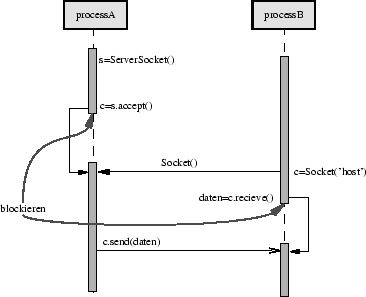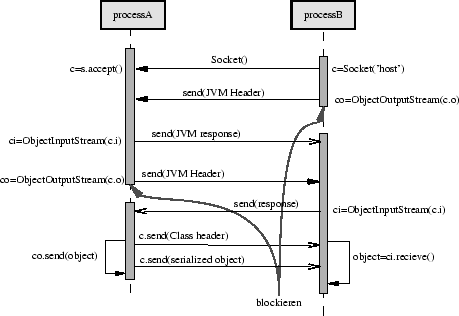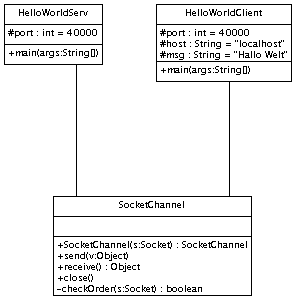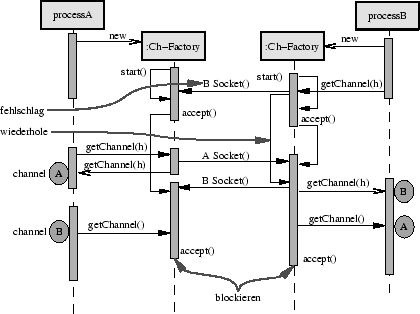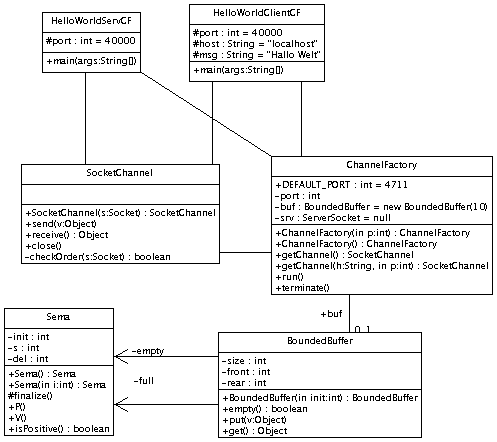Mehrprozessorsysteme ohne gemeinsamen Hauptspeicher benötigen spezielle Leitungen zur Kommunikation.
- Ethernet
- Fast-Ethernet
- TCP/IP, Sockets
- Myrinet
- SCI
- ATM
- Programmierung erfordert die Definition von
- geeigneten Leitungen
- Übertragungsprotokollen
- explizite Befehle zum Senden und Empfangen
- kein Schutz von gemeinsamen Variablen erforderlich
Das Schema des Nachrichtenaustauschs ist in Abbildung 2 dargestellt.
- Java Kommunikation basiert auf TCP/IP Sockets
- von praktisch allen Betriebssystemen unterstützt
- nahezu jede Treiber-Software von Netzwerk Hardware bietet Unterstützung für TCP/IP
- insbesondere auch High Performance Netzwerke
- Sockets sind aus Programmiersicht die Software-Schnittstelle zum Netzwerk
- entsprechen etwa den Filehandles
- Java-Netzwerk-Support im Package java.net
- eine oder mehrere Punkt-zu-Punkt Verbindungen
- keine 1-zu-n- oder m-zu-n-Verbindungsnetzwerke
3.1 Sockets
- Implementierung von Verbindungen mit
- Java Klassen ServerSocket und Socket
- Socket-Verbindung wird unsymmetrisch aufgebaut
- ein Ende (der Server Socket) wartet auf Verbindungswunsch
- anderes Ende (der Client Socket) versucht eine Verbindung aufzubauen
- wenn dies auf beiden Seiten gelingt besteht ein zuverlässiger Verbindungskanal
- ab dann Senden und Empfangen möglich
Spezifikation von ServerSocket:
public ServerSocket(int port) throws IOException public Socket accept() throws IOException
- Konstruktor ServerSocket erzeugt einen neuen Server Socket an port
- bei Portnummer 0 an einem beliebigen freien Port
- Methode accept() wartet auf einen Verbindungswunsch
- gibt einen Socket für die Verbindung zurück
- blockiert bis eine Verbindung zustande kommt
Spezifikationen von Socket
public Socket(String host, int port)
throws UnknownHostException, IOException
public InputStream getInputStream() throws IOException
public OutputStream getOutputStream() throws IOException
- Konstruktor Socket erzeugt neuen Client Socket
- zu dem angegebenen host und port
- stellt Eingabe- und Ausgabe-Strom zur Verfügung
- Zugriff mit getInputStream() und getOutputStream()
- Strom (Stream) ist eine unformatierte und unstrukturierte Folge von Daten
- InputStream und OutputStream bestehen aus Folgen von Bytes
Zuordnung von passenden Datenströmen:
- reine Unicode Zeichen mit Reader und Writer
- im folgenden ObjectStream
- Austausch beliebiger serialisierbarer ( serializable) Objekte
- Umwandlung von Java-Objekten in einen Daten-Strom
- und typsicheres Versenden und Empfangen
- auch für Datei-Ströme verwendbar
- akzeptiert nur Objekte, die das java.io.Serializable Interface implementieren
- ist eins der wesentlichen neuen Features von Java 1.1.
- auomatische Serialisierung überschreibbar
- dann muß man die Klasse selbst kodieren und dekodieren
- bei Filehandles keine Serialisierung sinnvoll
- Strom-Header enthält eindeutige Identifikation der Objekt-Strom-Klasse
Spezifikation der benötigten Konstruktoren und Methoden
public ObjectOutputStream(OutputStream out) throws IOException
public void flush() throws IOException
public ObjectInputStream(InputStream in)
throws IOException, StreamCorruptedException
- Konstruktor ObjectOutputStream erzeugt neuen Objekt-Ausgabestrom
- zu einem gegebenen OutputStream
- flush() verschickt Daten unmittelbar
- Konstruktor ObjectInputStream erzeugt neuen Objekt-Eingabestrom
- zu einem gegebenen InputStream
- Passt die Identifikation nicht wird eine StreamCorruptedException ausgelöst
- z.B. inkompatible JDK-Version, inkompatible Serialisierung
- blockiert, bis ein Objekt-Ausgabe-Strom die entsprechenden Daten gesendet
Datenübertragung mit Send-Operation ( send) und Empfangs-Operation ( recieve).
Spezifikation aus ObjectOutputStream
public final void writeObject(Object obj)
throws IOException
- writeObject() schreibt ein Objekt auf den Ausgabe-Strom
- der gesamte Graph des Objekts wird zerlegt (serialisiert)
- und mit dem Klassennamen und Klassensignatur geschrieben
Spezifikation aus ObjectInputStream
public final Object readObject()
throws OptionalDataException,
ClassNotFoundException, IOException
- readObject() liest ein Objekt von dem Eingabe-Strom
- der Klassenname und Klassensignatur wird gelesen
- der gesamte Graph des Objekts wird gelesen
- und rekonstruiert
3.2 Beispiel SocketChannel
Der Konstruktor nimmt einen Socket als Eingabe und setzt die Objekt-Ströme aus den entsprechenden Strömen auf.
Die Methode close() dient zum schließen des Kanals.
send()- und receive()-Methoden dienen der Datenübertragung
import java.io.*;
import java.net.*;
public class SocketChannel {
private ObjectInputStream in;
private ObjectOutputStream out;
private Socket soc;
public SocketChannel(Socket s) throws IOException {
soc = s;
if (checkOrder(s)) {
in = new ObjectInputStream(s.getInputStream());
out = new ObjectOutputStream(
s.getOutputStream());
}
else {
out = new ObjectOutputStream(
s.getOutputStream());
in = new ObjectInputStream(s.getInputStream());
}
}
public void close() {
if (in != null) {
try { in.close(); } catch (IOException e) { }
}
if (out != null) {
try { out.close(); } catch (IOException e) { }
}
if (soc != null) {
try { soc.close(); } catch (IOException e) { }
}
}
private boolean checkOrder(Socket s)
throws IOException {
int p1 = s.getLocalPort();
int p2 = s.getPort();
if (p1 < p2) return true;
else if (p1 > p2) return false;
int a1 = s.getLocalAddress().hashCode();
int a2 = s.getInetAddress().hashCode();
if (a1 < a2) return true;
else if (a1 > a2) return false;
throw new IOException(); // this shouldn't happen
}
}
- die Reihenfolge der Erzeugung der Objekt-Ströme out und in muß vertauscht sein
- da sich Objekt-Ströme bei dem Verbindungsaufbau über die Verwendung der gleichen Klassen und JDK-Versionen einigen müssen
- Methode checkOrder vertauscht
- auf dem gleichen Host sind die Ports verschieden, sonst die IP-Adressen
Die Sende- und Empfangs-Methoden sind wie folgt.
public void send(Object v) throws IOException {
out.writeObject(v);
}
Im Fehlerfall wird eine IOException ausgelöst,
die dann vom Aufrufer behandelt werden muß.
public Object receive()
throws IOException,
ClassNotFoundException {
return in.readObject();
}
Neben einer IOException kann auch noch eine
ClassNotFoundException ausgelöst werden,
falls das Objekt zu einer dem Empfänger unbekannten Klasse
gehört.
3.2a Beispiel HelloWorld mit SocketChannel
Implementierung: HelloWorldClient.java HelloWorldServ.java SocketChannel.java
3.3 Beispiel Kanalfabrik
- gleichzeitiger Aufbau von mehreren Punkt-zu-Punkt Verbindungen
- etwas mühsam, da Sockets immer eine Unterscheidung in Clients und Server erzwingen
- z.B. 100 Prozesse in 2d-Torus-Topologie
- pro Prozeß vier Verbindungen (links, rechts, oben und unten)
- Deadlock falls die Reihenfolge des Verbindungsaufbaus nicht abgestimmt
- z.B. nicht alle Prozesse können in einer Reihe den linken Kanal gleichzeitig aktivieren
- und Client kann erst versuchen Verbindung aufzubauen, wenn Server-Teil gestartet
Zwei Grundideen zur Lösung
- die accept()-Aufrufe in Thread auszulagern
- Aufrufe von new Socket() wiederholen, falls Server noch nicht bereit
- Implementierung in ChannelFactory
- zwei Methoden getChannel() erzeugen SocketChannel
- für die Client-Seite mit angebenem Hostnamen
- für die Server-Seite ohne Hostnamen
Der Konstruktor der Klasse ChannelFactory erzeugt einen Server-Socket und startet sich dann selbst als Thread.
import java.io.*;
import java.net.*;
public class ChannelFactory extends Thread {
public final static int DEFAULT_PORT = 4711;
private int port;
private BoundedBuffer buf = new BoundedBuffer(10);
private ServerSocket srv = null;
public ChannelFactory(int p) {
if (p<=0) { port = DEFAULT_PORT; }
else { port = p; }
try {
srv = new ServerSocket(port);
this.start();
System.out.println(
"server started on port "+port);
} catch (IOException e)
{ System.out.println(e); }
}
public ChannelFactory() {
this(DEFAULT_PORT);
}
- in run() wird in einer Endlosschleife mit accept() gewartet
- trifft eine Anfrage ein, wird aus dem Socket ein SocketChannel erzeugt
- wird in einem Puffer buf gespeichert
- dann warten auf die nächste Anfrage
- getChannel() liefert einen der gespeicherten SocketChannel
- falls keine Verbindung gespeichert, blockiert die Methode bei buf.get().
public void run() {
while (true) {
try {
System.out.println(
"waiting for connection");
Socket s = srv.accept();
System.out.println("connection accepted");
SocketChannel c = new SocketChannel(s);
buf.put( (Object) c );
} catch (IOException e) {
System.out.println(e);
}
}
}
public SocketChannel getChannel()
throws IOException {
return (SocketChannel)buf.get();
}
- auf Client-Seite ist getChannel(String h, int p) umfangreicher
- Versuch mit new Socket(host,port) eine Socket-Verbindung aufzubauen
- in einer while-Schleife solange, bis die Verbindung zustande kommt
- d.h. bis der gewünschte Server-Teil bereit ist
public SocketChannel getChannel(String h, int p)
throws IOException {
if (p<=0) { p = port; }
SocketChannel c = null;
System.out.println("connecting to "+h);
while (c == null) {
try { c = new SocketChannel(
new Socket(h, p) );
} catch (IOException e) {
System.out.println(e);
// wait server ready
System.out.println("Server on "+h+
" not ready");
try {
Thread.currentThread().sleep(
(int)(5000));
} catch (InterruptedException e1) { }
}
}
System.out.println("connected");
return c;
}
}
ChannelFactory löst das Reihenfolge-Problem und das Deadlock-Problem.
Das Reihenfolge-Problem wird durch Warten und Neuversuch in der Methode getChannel(String h, int p) gelöst.
Die Lösung des Deadlock-Problems wie folgt.
Wir setzen voraus, daß für jeden Prozeß genau einmal der Konstruktor ChannelFactory() und für jeden Kanal genau einmal die Methode getChannel() und die Methode getChannel(String h, int p) aufgerufen wird.
Betrachten wir die drei Programmzustände:Aufruf der Konstruktoren ChannelFactory(). Damit wird ein Thread gestartet, der Verbindungsanfragen vom Server-Socket entgegennimmt und speichert.
Aufruf von getChannel(String h, int p) auf allen Client-Seiten der Kanäle. Dabei wird die Verbindung zu Sockets aus Punkt 1 hergestellt. Falls diese noch nicht bereit sind, wird gewartet.
Aufruf von allen getChannel() auf den Server-Seiten der Kanäle. Dabei werden nur noch die gespeicherten Verbindungen zurückgegeben. Falls noch keine gespeichert sind, wird gewartet.
- der Konstruktor von Punkt 1 kann auf jedem beteiligten Rechner terminieren denn nur Thread gestartet, der auf Verbindungen wartet
- damit terminieren auch alle Programmteile mit Punkt 2 einmal, denn sie können die gewünschte Verbindung aufbauen.
- damit können auch alle Programmteile mit Punkt 3 terminieren, denn alle Verbindungen sind schon aufgebaut und gespeichert.
- somit ist das Deadlock-Problem beim Verbindungsaufbau gelöst
Kompliziertere Verbindungsstrukturen mit virtuellen Kanälen oder PVM oder MPI.
3.3a Beispiel HelloWorld mit ChannelFactory
Implementierung: HelloWorldClientCF.java HelloWorldServCF.java ChannelFactory.java

